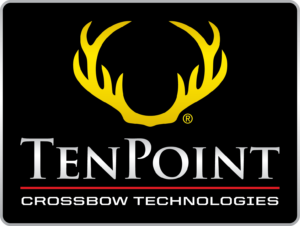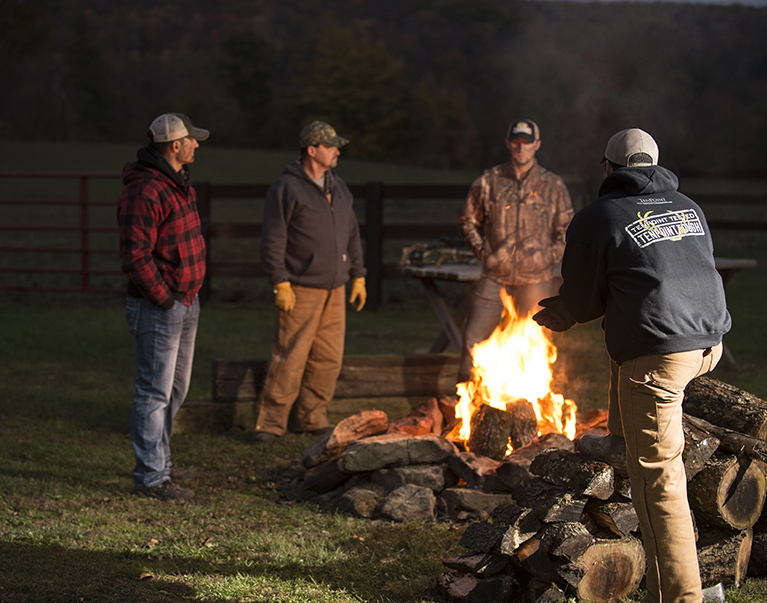
Our Story
For over 30 years, our goal has remained unchanged:
To be a world class manufacturer of products that are recognized as an industry standard for safety, accuracy, precision engineering, durability, performance and power.
We design, build, and test our crossbows here in the U.S.A. Doing so enables us to control the process and use the best parts and materials available, thereby guaranteeing a final product of uncompromising quality and creating jobs right here in Ohio.
Please choose from the options below to learn more about the TenPoint story.
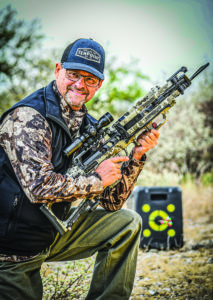 The evolution of TenPoint Crossbow Technologies began with the upbringing of Rick Bednar. Rick’s association with archery and the archery industry goes back to his youth when his parents, Archery Hall of Famer, Bill Bednar, and his wife, Edith, founded Portage Archery Center in Suffield, OH. Rick and his sisters, Cindy and Joanna, who work for TenPoint as well, grew up in an apartment adjoining the pro shop building. That shop still operates today as Hunter’s Outlet Archery Center, a Division of TenPoint Crossbow Technologies.
The evolution of TenPoint Crossbow Technologies began with the upbringing of Rick Bednar. Rick’s association with archery and the archery industry goes back to his youth when his parents, Archery Hall of Famer, Bill Bednar, and his wife, Edith, founded Portage Archery Center in Suffield, OH. Rick and his sisters, Cindy and Joanna, who work for TenPoint as well, grew up in an apartment adjoining the pro shop building. That shop still operates today as Hunter’s Outlet Archery Center, a Division of TenPoint Crossbow Technologies.
As he grew up immersed in the family’s business, his father, Bill, also coached him as an elite tournament archer. Competing at the highest collegiate, national, and international levels, he traveled the world as a member of the USA Pan Am, World Target and World Field Archery teams; qualified for the 1976 Olympic Team; and won the NCAA Championship three-times at The University of Akron. Both his retail and competition background nurtured a strong interest in and appreciation for bow design, performance, and engineering.
Following graduation in 1979, he went to work for specialty retailer, Cole National Corporation, as its Director of New Store Expansion. Within two years, however, he knew his true interest centered on becoming his own boss. He purchased the family business in 1981. By 1983, he had added a wholesale distribution component to the retail operation called PAC Distributing.
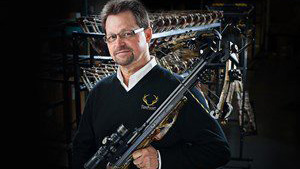 Two years later, the distributorship caught the attention of a group of British entrepreneurs who convinced Rick to form an Ohio-based national sales and marketing organization to import and sell a line of crossbows – a market in its infancy – designed by British custom gun maker, Bernard Horton. Within one year, it became clear that Horton’s British operation could not produce and ship product fast enough to fill the orders Rick had written. Realizing the crossbow business had great long-term potential, he convinced Horton to move the manufacturing to Suffield, Ohio, where sourcing component parts was a comparative breeze.
Two years later, the distributorship caught the attention of a group of British entrepreneurs who convinced Rick to form an Ohio-based national sales and marketing organization to import and sell a line of crossbows – a market in its infancy – designed by British custom gun maker, Bernard Horton. Within one year, it became clear that Horton’s British operation could not produce and ship product fast enough to fill the orders Rick had written. Realizing the crossbow business had great long-term potential, he convinced Horton to move the manufacturing to Suffield, Ohio, where sourcing component parts was a comparative breeze.
In 1985, Rick led the effort to recapitalize the new operation and incorporate it as Horton Crossbow Manufacturing Company, Inc. In six short years as COO, he grew the company from zero to a thriving $4.5 million company, employing nearly 30 people. By 1990, Stark County recognized his success by awarding him their New Entrepreneur of the Year Award.
Rick decided to leave Horton to start a new crossbow company – Hunter’s Manufacturing. His vision for Hunter’s was significantly different than Horton’s vision. Rick wanted to focus on building the highest quality hunting crossbows in the world rather than the highest quantity. He sat out a non-compete covenant during the following year.
On January 4, 1994, he and a small group of additional investors formed Hunter’s Manufacturing Company, Inc. The difference between launching Horton in 1985 and Hunter’s Manufacturing in 1994, however, was monumental. Horton had the advantage of beginning its operations in an emerging market with no significant competition. Hunter’s started while the market was still in its infancy, but Horton had already established a foothold as the industry leader.
As soon as Hunter’s Manufacturing launched in 1994, Horton employed a strategy to block its progress at every turn, including filing a lawsuit which put a squeeze on Hunter’s Manufacturing’s operating capital. Hunter’s Manufacturing eventually reached an out-of-court settlement with Horton by the end of 1998. The settlement awarded no financial compensation to Horton, but Hunter’s did agree to change its trade name to TenPoint Crossbow Technologies beginning at the start of year 2000.
Rick chose the name “TenPoint” out of a desire to more clearly separate the company from its competitors and because the word “ten” suggests perfection, like in the phrase, “a perfect 10,” which is a complement to the original Hunter’s Manufacturing Company slogan, “the mark of perfection.”
Even though the five years leading up to 2000 were difficult, the company, nevertheless, survived, managing double-digit growth each year. With the lawsuit no longer a distraction, the marketplace started to recognize TenPoint’s engineering and performance superiority. In addition, the fledgling crossbow market began expanding at a slow but unmistakable pace.
In 2003, a couple of southeastern states eliminated crossbow restrictions during their archery seasons. Since then, what was a five-state market began to evolve – in domino fashion – into what is now an explosive and rapidly growing 28-state, full-inclusion-archery-season market. In most of these states, TenPoint was at the forefront in advocating for the legalization and full-inclusion of crossbows as viable hunting weapons by working to educate hunters, state agency decision makers, and politicians.
Crossbow legislation continued to expand with states such as Wisconsin, Michigan, Missouri, New York and Kentucky getting full crossbow hunting seasons. The expanded opportunities have helped crossbows grow tremendously popular as a hunting weapon, and crossbows have allowed many additional hunters to get in the woods. Thanks to TenPoint’s cutting-edge crank-style cocking devices like the ACUdraw, ACUdraw PRO, and ACUslide Safe Cocking and De-Cocking System that reduce bowstring draw weights by up to 95%, hunters who have physical limitations or disabilities can still participate in archery hunting.
While favorable state regulations created a welcome pathway to success between 2003 and 2020 for crossbow manufacturers, few companies were able to navigate that path as well as TenPoint. Under Rick’s direction, the company has grown from under 20 employees to 100 during during this time span.
TenPoint is a charter member of the North American Crossbow Federation and continues to this day to advocate for full-inclusion of crossbows in archery hunting seasons in states around the country.
Click HERE for a map detailing current crossbow regulations throughout the United States.
 Under Rick’s direction, TenPoint secured its first patents in 1995 for a bow-to-barrel sound dampening system called the VibraCush and a dry-fire prevention mechanism called the Dry-Fire-Inhibitor. Shortly after the initial patents, the ACUdraw, a ground-breaking gear assisted cocking device, received it’s first of many patents in 1996. TenPoint has improved upon the original ACUdraw design to produce the ACUdraw PRO cocking device and the ACUslide Safe Cocking and De-Cocking System.
Under Rick’s direction, TenPoint secured its first patents in 1995 for a bow-to-barrel sound dampening system called the VibraCush and a dry-fire prevention mechanism called the Dry-Fire-Inhibitor. Shortly after the initial patents, the ACUdraw, a ground-breaking gear assisted cocking device, received it’s first of many patents in 1996. TenPoint has improved upon the original ACUdraw design to produce the ACUdraw PRO cocking device and the ACUslide Safe Cocking and De-Cocking System.
Since then, the company has secured 94 additional U.S. and 2 Canadian patents with several more patents currently pending. No other company in the industry has a record of technological achievement that can compare.
In 2004, the Cleveland District of the U.S. Small Business Administration named Rick as its Small Business Person of the Year. In the same year, TenPoint received its first Cascade Capital Business Growth Award, a tri-county growth award it has received every year but one since then. In 2014, Rick received the Ernst & Young Entrepreneur of the Year Award for the Northeast Ohio Region for excellence in the Innovation &Technology Products and Services category.
Click HERE for a detailed list of our patents.
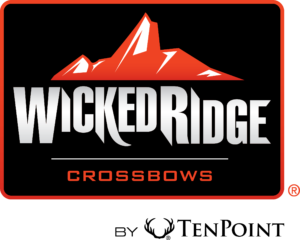 In 2008, Rick’s oldest son, Phil, joined the company as the Marketing Assistant after graduating with an MBA from the University of Akron. Since that time, Phil has served as both the Assistant Director and Director of Marketing, leading up to his current position as Executive Vice President of Sales & Marketing.
In 2008, Rick’s oldest son, Phil, joined the company as the Marketing Assistant after graduating with an MBA from the University of Akron. Since that time, Phil has served as both the Assistant Director and Director of Marketing, leading up to his current position as Executive Vice President of Sales & Marketing.
One of Phil’s most significant contributions to the company has been the creation and cultivation of the Wicked Ridge brand, an easy-to-manufacture entry-level line of crossbows that – while simple in design- are nevertheless as durable, accurate, and dependable as their high-end TenPoint predecessors were.
Wicked Ridge Crossbows was introduced in 2010 as a value-priced second brand in the TenPoint Family.
Phil was involved in every aspect of building the Wicked Ridge brand. He made the decisions on the brand name, bow names, pricing, camo selection, bow labels, brand colors, packaging, ads, catalogs, etc.
He knew that there was significant business to be gained in the entry-level market. At that time, $399 was the opening price point and another manufacturer had most of that business. Phil knew that this new Wicked Ridge brand would take some of that business and profitability due to TenPoint’s strong quality reputation and retailer relationships.
Wicked Ridge has now grown into an independently successful hunting crossbow brand with six models ranging from just $399.99-$1099.99.
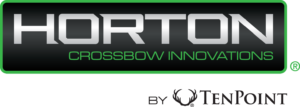 In April 2013, the original crossbow company that Rick helped start in the 1980’s, Horton Archery LLC, permanently closed its doors and filed for bankruptcy. Sensing an opportunity to gain market share in the wake of Horton’s absence, Rick sought to purchase selected Horton Archery assets, including machinery, equipment, trademarks, patents, and licenses from Horton’s secured creditor.
In April 2013, the original crossbow company that Rick helped start in the 1980’s, Horton Archery LLC, permanently closed its doors and filed for bankruptcy. Sensing an opportunity to gain market share in the wake of Horton’s absence, Rick sought to purchase selected Horton Archery assets, including machinery, equipment, trademarks, patents, and licenses from Horton’s secured creditor.
On July 8, 2013, Rick announced the successful purchase of Horton Archery LLC’s assets, the most important of which was a licensing agreement with Scorpyd Crossbows to design and produce reverse-draw style hunting crossbows. Horton was re-launched in 2015 as Horton Crossbow Innovations. This new company’s design focus became reverse-draw technology, yielding innovative, American-Made designs like the Storm RDX and the Vortec RDX models.
The licensing to design and build reverse-draw crossbows has also allowed TenPoint to incorporate this design-style into TenPoint-branded crossbow models like the Nitro XRT and the Vapor RS470, which are considered to be the most accurate and highest performing hunting crossbows ever to be produced.
From our inception, TenPoint Crossbow Technologies has led the crossbow industry in innovation and technology, and, in 2018 we did not disappoint. We provided the marketplace with new hunting crossbow designs that were ultra-narrow, at only 6-inches wide when fully cocked, enabled by the introduction of the game-changing Vector Quad Cable System. We also broke the 400 feet-per-second barrier by introducing the popular Stealth NXT and the Nitro X crossbow models.
In 2020, we have revolutionized the crossbow market again with the launch of our new ACUslide Cocking and De-Cocking System – as “The Industry’s First Silent Cocking, Safe De-cocking System”. Far superior to any cocking or de-cocking system on the market, the ACUslide allows the user to silently cock and safely de-cock the crossbow. The most innovative part of the de-cocking design is its ease of use – just simply backwind the handle – without fear of injury, bow damage, and losing control.
As the Executive VP of Marketing & Sales, Rick’s son Phil is the New Product Development Team leader. “I am one of the conceptual leaders for new products, and I try to identify holes in the market where we can develop a new product to grow sales and gain market share. We rely on consumer, dealer, and sales representative feedback to shape our improvements.”
The best ideas for product development come directly from customer reviews, recommendations and feedback. We believe that the folks who use our crossbows are in the best position to give us the feedback that will drive our technological push forward. For example, our development of the ACUslide Safe Cocking & De-Cocking System was primarily driven by requests from our customers over the past few years to build a safe and silent cocking system that allows a crossbow to be cocked and de-cocked with ease. As a result, crossbow consumers have responded with an unprecedented level of interest in our crossbow models that utilize this cocking system.
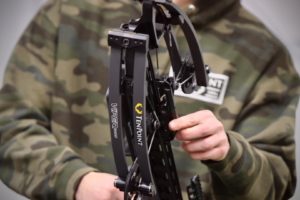 We recognize that one of our greatest strengths as a company has been our undying commitment to continuous product innovation. Year after year, decade after decade, we have discovered new ways to push the boundaries of crossbow technology to produce the finest hunting crossbows made in the world. With this kind of history, we know that our future holds some exciting new advancements, some of which are in the testing stages right now. According to Phil, the future of TenPoint lies in “continued innovation to push the envelope in crossbow technology. We want to make the user experience better each year. Our goal is to keep innovating and getting better each year.”
We recognize that one of our greatest strengths as a company has been our undying commitment to continuous product innovation. Year after year, decade after decade, we have discovered new ways to push the boundaries of crossbow technology to produce the finest hunting crossbows made in the world. With this kind of history, we know that our future holds some exciting new advancements, some of which are in the testing stages right now. According to Phil, the future of TenPoint lies in “continued innovation to push the envelope in crossbow technology. We want to make the user experience better each year. Our goal is to keep innovating and getting better each year.”
When getting better each year is your goal, you must become heavily invested in reaching it. That is why, over the past few years, we have invested millions of dollars in the creation of our Engineering, Research, and Design Center. We have built a team that includes Rick’s nephew and Phil’s cousin, Mike Shaffer, who serves as the Director of Engineering. We have invested in 3-D printing and CNC machining capabilities that allow us to design, prototype, and test future products in-house, so that we are confident when we bring a new crossbow model to market what you will receive is one of the most accurate, precisely-made, and durable hunting crossbows available.
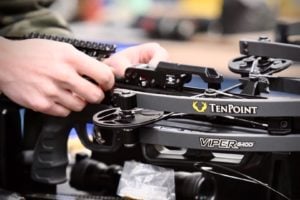 As crossbow technology evolves, the production process to build new crossbow designs must also evolve to ensure a high-quality finished product and to meet consumer demand. After graduating in 2013 from Ashland University with a degree in Supply Chain Management, Rick’s youngest son, Steve, filled many different positions within the company and now sits as Executive VP of Operations, overseeing the entire production process. When designing the production line to handle our new line-up of high-performance crossbows, Steve explains, “The assembly line was something we discussed for 2-years prior to implementing it. We even built a test line, where we ran bows down a mocked-up assembly line. As a result, we have been able to increase the production of crossbows per person by 15-20%.”
As crossbow technology evolves, the production process to build new crossbow designs must also evolve to ensure a high-quality finished product and to meet consumer demand. After graduating in 2013 from Ashland University with a degree in Supply Chain Management, Rick’s youngest son, Steve, filled many different positions within the company and now sits as Executive VP of Operations, overseeing the entire production process. When designing the production line to handle our new line-up of high-performance crossbows, Steve explains, “The assembly line was something we discussed for 2-years prior to implementing it. We even built a test line, where we ran bows down a mocked-up assembly line. As a result, we have been able to increase the production of crossbows per person by 15-20%.”
As Executive VP of Operations, Steve sees his role of overseeing the production process as critical to building the most accurate, most dependable hunting crossbows on the market today. According to Steve, “I enjoy integrating technology into our assembly process, and my main goal is to create a production line that is error-proof. We have accomplished this by integrating visual inspection into the process along with having the capability to track parts back to the original lot and manufacturer.”
Perhaps most exciting is our recent addition of a test-firing range at the end of the production line where our newest crossbow models are test-fired for accuracy and shot through a chronograph to verify performance. Each new crossbow receives a “birth certificate” that includes these test results, and a copy of this certificate is provided in the box for the consumer. In the future, this test-firing verification process will be extended to all TenPoint and Wicked Ridge crossbows that we build.


